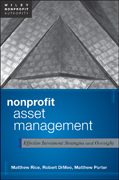
Nonprofit asset management: effective investment strategies and oversight
Rice, Matthew
DiMeo, Robert A.
Porter, Matthew
An authoritative guide for effective investment management and oversight of endowments, foundations and other nonprofit investors Nonprofit Asset Management is a timely guide for managing endowment, foundation, and other nonprofit assets. Taking you through each phase of the process to create an elegant and simple framework for the prudent oversight of assets, this book covers setting investment objectives; investment policy; asset allocation strategies; investment manager selection; alternative asset classes; and how to establish an effective oversight system to ensure the program stays on track. Takes you through each phase of the process to create an elegant and simple framework for the prudent oversight of nonprofit assets A practical guide for fiduciaries of endowment, foundation, and other nonprofit funds Offers step-by-step guidance for the effective investment management of assets Created as a practical guide for fiduciaries of nonprofit funds--board members and internal business managers--Nonprofit Asset Management is a much-needed, step-by-step guide to the effective investment management of nonprofit assets. INDICE: Foreword Preface Acknowledgments Chapter 1: The Three Levers and the Investment Policy Investment Policy Statement Investment Strategy Duties and Responsibilities Investment Manager Evaluation Conclusion Chapter 2: Asset Allocation Modern Portfolio Theory Capital Market Assumptions: The Building Blocks of Portfolio Construction Shortcomings of Modern Portfolio Theory Probabilistic Optimization Models The Frontier Engineer In the Long Run Strategic, Tactical, and Integrated Asset Allocation Steering Mechanisms The Low Volatility Tailwind Tail Risk Hedging Counterparty Risk Portfolio Rebalancing Conclusion Note Chapter 3: Traditional Global Financial Asset Classes Fixed Income Asset Classes Conclusion Notes Chapter 4: Traditional Asset Class Manager Selection Manager Search and Selection Investment Vehicles Active versus Passive Management When to Terminate a Manager Conclusion Chapter 5: Hedge Funds The Evolution of Hedge Funds Modern Hedge Fund Strategies Why Invest in Hedge Funds? Alpha-Beta Framework, Hedge Funds and Fees Hedge Fund Indices and Benchmarks Hedge Fund Terms and Structures Fund of Hedge Funds versus Direct Investment Hedge Fund Investment Due Diligence Hedge Fund Operational Due Diligence Hedge Funds in the Post-2008 World Conclusion Note Chapter 6: Private Equity Private Equity Investment Strategies Why Invest in Private Equity? Structure and Terms Private Equity Risks Direct Private Equity versus Private Equity Fund of Funds Selecting Private Equity Managers Benchmarks Conclusion Notes Chapter 7: Real Assets Commodities Equity Real Estate Investment Trusts and Private Real Estate Farmland Energy Infrastructure Master Limited Partnerships Broad InfrastructureInvesting Timberland Gold Other Investible Real Asset Categories Conclusion Note Chapter 8: Performance Measurement and Evaluation Why Monitor Performance?Performance Calculations Benchmarks Market Index Basics Investment Style Major Market Indices Determining the Right Index Peer Group Universes Modern Portfolio Theory Performance Metrics Style Analysis Portfolio Analysis Performance Reporting Conclusion Chapter 9: Structuring an Effective Investment Committee Procedures Committee Structure Committee Makeup When an Investment Committee Needs Outside Help Effective Use of the Consultant Conclusion Chapter 10: Outsourced CIO Services Overview Why Outsource? Outsourced Services What is done inconjunction with the committee? Potential Benefits Finding a Firm Characteristics The RFP Interviewing Finalists Fees The Contract Reporting Conclusion Chapter 11: Environmental, Social, and Corporate Governance Focused Investing History and Evolution Negative Screening Positive Screening Shareholder Advocacy Community Investing Strategy Considerations Investment Selection Separate Accounts Mutual Funds Commingled Funds Exchange-traded Funds Alternative Investments Performance Impact of ESG Incorporating ESG into Investment Policy Conclusion Notes Chapter 12: Selecting Vendors Custod
- ISBN: 978-1-118-00452-4
- Editorial: John Wiley & Sons
- Encuadernacion: Cartoné
- Páginas: 252
- Fecha Publicación: 08/02/2012
- Nº Volúmenes: 1
- Idioma: Inglés
